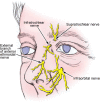Novel Extranasal Tear Stimulation: Pivotal Study Results
- PMID: 33244443
- PMCID: PMC7683850
- DOI: 10.1167/tvst.9.12.23
Novel Extranasal Tear Stimulation: Pivotal Study Results
Abstract
Purpose: To evaluate the efficacy and safety of iTEAR, a novel, portable, sonic external neuromodulation device, for the treatment of dry eye disease (DED).
Methods: This was a multicenter, open-label, single-arm clinical trial that included adult patients with DED with a Schirmer score of ≤10 mm in at least one eye. Enrolled subjects were instructed to apply the study device at least twice per day for 30 seconds bilaterally to the external nasal nerve. After the initial baseline visit, patients were followed up at days 3, 14, 30, 90, and 180. The primary efficacy endpoint was the Schirmer index (change from unstimulated to stimulated tear production as measured by the Schirmer test) at day 30. The major secondary endpoint was the change in symptoms of DED at day 30 evaluated using the Ocular Surface Disease Index (OSDI).
Results: A total of 101 subjects evaluated at day 30 had a mean Schirmer index of 9.4 mm (95% confidence interval [CI], 7.4-11.3), and the baseline OSDI improved by an average of 14.4 (95% CI, 11.1-17.7). Both endpoints were highly statistically and clinically significant at all time points. There were two mild unanticipated adverse events definitely related to the device.
Conclusions: The safety and efficacy of the iTEAR device observed in this study support its indication for treating DED.
Translational relevance: Neurostimulation has the potential to improve signs and symptoms of DED.
Keywords: dry eye disease; dry eyes; lacrimal gland; neurostimulation.
Copyright 2020 The Authors.
Conflict of interest statement
Disclosure: M.H. Ji, None; D.M. Moshfeghi, None; L. Periman (C); D. Kading (C); C. Matossian, None; G. Walman, None; S. Markham, None; A. Mu, None; A. Jayaram, None; M. Gertner, Olympic Ophthalmics, Inc. (F, I); P. Karpecki (C); N.J. Friedman (C, I)
Figures





References
-
- Schaumberg DA, Sullivan DA, Buring JE, Dana MR. Prevalence of dry eye syndrome among US women. Am J Ophthalmol. 2003; 136(2): 318–326. - PubMed
-
- Lemp MA, Baudouin C, Baum J, et al. .. The definition and classification of dry eye disease: report of the definition and classification subcommittee of the International Dry Eye WorkShop (2007). Ocul Surf. 2007; 5(2): 75–92. - PubMed
-
- Shimazaki J. Definition and diagnostic criteria of dry eye disease: historical overview and future directions. Invest Ophthalmol Vis Sci. 2018; 59(14): DES7–DES12. - PubMed
Publication types
MeSH terms
LinkOut - more resources
Full Text Sources
Medical

